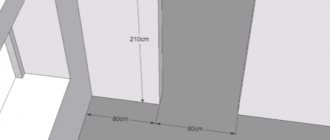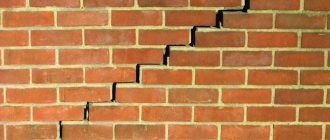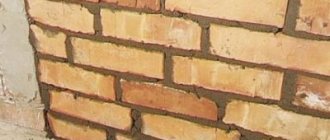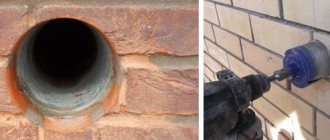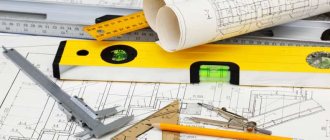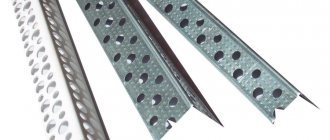Applications of reinforced cage
In order to strengthen the walls and prevent new damage from occurring, you can reinforce the walls.
This can be done using reinforcement cages, metal rods or reinforcing mesh. The simplest option is to carry out reinforcement using reinforcing mesh, in this case, the order of work will be as follows:
- You can fix the reinforcing mesh on the wall either on one side or on both sides;
- before this it is necessary to drill holes;
- To fasten the mesh, through studs are used or this can be done using anchor bolts;
- after attaching the mesh, concrete mortar is applied to it, the grade of which should not be lower than M 100;
- the thickness of the solution layer is usually in the range of 20-40 mm;
- auxiliary metal rods with a diameter of 6 mm are attached along the height of the corners, 25-30 cm retreat from the edge;
- if the mesh is installed on only one side, then studs or anchors with a diameter of 8 mm are used in increments of 60-75 cm;
- if the reinforcing mesh is attached to both sides of the wall, then the diameter of the studs is at least 12 mm and their pitch is 100-120 cm;
- The reinforcing mesh is attached to the anchors or studs using welding or knitting wire.
Possible errors and difficulties in the process
This subsequently leads to problems with thermal insulation and a decrease in the reliability of installation work.
Incorrectly made clearances will need to be redone, and this will lead to higher costs for construction work. To prevent this from happening, you will need to link the openings to the wall.
Particular attention is paid to the top of the slopes; it is checked taking into account the design of the finished floor. It happens that when making openings the required gaps on the sides of the box 30 mm and below 60 mm are not observed
Also, the shape of the opening is often incorrectly executed with violation of the diagonals, when they are not equal to each other.
Incorrect calculations of a reduced double-glazed window: after installing PVC structures, the glazing area becomes insufficient and cannot provide sufficient natural light to the room.
Process
The arrangement of lintels, with the formation of a unit and taking into account support in the wall, must take place according to the rules described in SNiPs. Since reinforced concrete lintels are used most often in modern buildings, the process of their installation consists of the following nuances:
- For laying, a ledge is made with a width of at least 25 cm, and on each side of the opening, the length of the structure should exceed this width by 50 cm.
- For installation, use a truck crane to lift the lintel - it will lift and lower it to the desired support point, onto which uncured concrete mortar has already been applied.
- With prefabricated options, formwork is arranged, formed along the width of the opening, a reinforcement cage is knitted and the lintels are poured in a monolithic manner, leaving them until completely dry.
Metal jumpers are lightweight. Presented in the form of channels and various forms of rolled steel, their advantage is that during operation they can be cut to the required length.
Brick lintels are mounted to the main wall along the top of the opening, and then connected to each other using a shelf from which hang clamps placed in vertical seams. The clamps reliably reinforce the lintel, and it turns out strong.
Recently, in most cases, builders have placed the professional BAUT reinforcement system into brick lintels.
A simple and reliable way to install a brick lintel - in the video:
Glazing of a loggia using an aluminum profile
Lightweight aluminum construction is most popular today due to the low cost of a fairly durable product. The high-strength structure chosen for the cold method of glazing the balcony space will last at least 80 years if it is installed correctly:
- we install the prepared wooden frame, seal all the cracks;
- We dismantle all sliding elements, remove glazing that is not tightly secured;
- We fix the canopy on the top plate with special fastening fittings, and also install ebb linings on the parapet;
- along the perimeter of the wall panels we attach mounting plates to the frame at pre-marked places;
- we return the previously dismantled elements of the balcony system, filling all the voids with polyurethane foam.
Video instruction:
Thanks to its modern design and wide range of colors, the aluminum profile can easily be adapted to any home interior. A significant disadvantage of aluminum structures is low noise insulation and a high probability of negative consequences associated with changes in ambient temperatures.
Is it always possible to cut into a concrete wall?
Work to create openings in concrete walls must be carried out in strict compliance with laws, building regulations and sanitary standards, taking into account fire safety. In most cases, when remodeling, it is unacceptable to touch load-bearing walls.
To obtain permission to carry out such work, you should think about how the reconstruction of the apartment does not entail damage to the entire building. To do this, you need to reinforce the opening in the load-bearing wall using metal structures. This applies to the upper floors; on the lower floors, changing the apartment plan may be prohibited.
When obtaining this permit, the following points are taken into account:
- the material from which the house is built;
- apartment layout;
- dimensions of the new opening and supporting structure;
- technical condition of the building and its ceilings;
- pressure exerted on the walls from above;
- wall thickness and condition.
In a private building, it is much easier to create a window or doorway in a concrete wall, since there are no lower or upper floors on which the load could increase. But it is imperative to take into account all aspects and details that may subsequently affect the stability of the floors of the house.
Unprofessional and illiterate redevelopment in a private house can lead to disastrous results, so before breaking through an additional opening, you need to study all the design features of the load-bearing walls of the house and find out the following:
- House project;
- the area of the new opening in relation to the area of the load-bearing wall;
- technical parameters of the house, the condition of its ceilings;
- thickness and strength of the load-bearing wall.
Do I need to take permission?
It is not worth starting redevelopment work without a preliminary inspection of the apartment. When changing the integrity of load-bearing structures, you will need to issue a package of permits. If this is not done, it will not be possible to sell the apartment after unauthorized redevelopment. The building may fall into disrepair due to unauthorized, ill-considered actions of one of the residents.
Changes to the design of conventional partitions are formalized upon completion of repair work. They notify the housing inspection and provide an application with a photocopy of the floor plan, on which the changes made are noted. The commission inspects the apartment on site and makes appropriate changes to the documentation.
What are the difficulties?
An opening can be made in an iron-concrete floor, if the design of the floor itself allows it. In other words, if this is an old house, where the ceiling slabs are narrow and long, then creating an opening will be almost impossible, since an opening of this size will disrupt the design of the slab, and it will have to be strengthened in such a way that, firstly, this will not be agreed upon in the redevelopment, and secondly , this will become very costly.
But in houses with monolithic floors, just now everyone is making openings to accommodate stairs, when creating a transition in two-story or more apartments and private houses. You can even place an elevator in such an opening.
Technically, it is necessary to ensure that the cut part of the slab is supported from below, and then we cut or saw out, drill around the perimeter, and lower the fragment of the ceiling down. Next, we chop it up and take out the trash.
Openings can be of various shapes and sizes.
In some cases, significant strengthening of structures with rolled metal is required.
Special diamond circular saws are used for cutting concrete. You can also use other available tools (a professional large grinder with two handles). Cooling is required during the cutting process.
This video demonstrates stationary cutting of concrete, when the saw is fixedly fixed on the floor of the ceiling using a special frame.
The second video shows a device for drilling holes in the ceiling; there is also reinforcement inside the ceiling..
If the reinforced concrete floor does not have a stiffener rib or the next level, or something heavy is not installed on the floor slab, then you can make an opening, there will be nothing wrong with it, but you must also remember that the reinforced concrete floor itself remains in place as long as there are ribs rigidity or reinforcement in it, if the structure is damaged, the slab may collapse, and even after the opening is made, this ceiling cannot be loaded in other places.
So, for example, if you make an opening in the ceiling a-1 or a-2 from one side to the other, the slab will collapse, the same can happen with slabs a-3 and a-4 if you cut off the stiffening ribs.
The opening itself can be cut in two ways:
- Drilling through holes along the contour of the opening a few millimeters apart.
- Cut the opening using a diamond blade.
I like the second option better, since the edges are initially smooth and do not require further processing.
And now ATTENTION!
When you cut an opening, it will fall from a height of at least 1.8 meters, and this is fraught with destruction in the house, since the opening will be very heavy, because it is made of concrete and metal structures. Therefore, before cutting the opening, it is necessary to ensure safety so that the cut piece does not fall.
An opening in a reinforced concrete floor can only be made if you have some experience in construction and have coordinated this type of work with the competent authorities, since during the manufacture of the opening you will weaken the reinforced concrete slab, which can lead to the collapse of the rest of the slab or the destruction of the room, and this can cause damage to health people and even death. Therefore, you should not do this work yourself; use the help of specially trained people with a license (permit) to perform this type of work!
Types of sliding windows
All sliding windows have a similar design. But they can be made of different materials. There are only two types of such windows: aluminum profiles and plastic. Let's look at the design features, advantages and disadvantages of each of these types.
Aluminum sliding windows
Sliding windows made of aluminum profiles have the following design: guides are installed on the frame, along which the window sashes move. The sashes are equipped with special polymer-coated rollers that ensure smooth movement of the sashes. They are closed using a latch mechanism, and fittings in the form of handles are also installed on the doors. The entire system is sealed with brush seals.
For this type of window, two types of profiles are used: regular and reinforced. The second is used in cases where the glazing is planned to be placed beyond the balcony railings, or on high floors of buildings.
The advantages of aluminum sliding windows are:
- Low price;
- The ability to extend the glazing beyond the perimeter of the balcony using a bracket system, which allows you to expand the free space of very small balconies;
- Aluminum is a durable material that is not susceptible to corrosion, which means that structures made from it have a long service life;
- Such windows are light in weight, so there is no need to strengthen the balcony floor structure for their installation;
But this type of glazing also has its disadvantages, which in many cases turn out to be significant:
- Since aluminum is a metal, it freezes quickly in the winter, and in this case it will be almost impossible to open the doors;
- Not only the guides freeze, but also the window lock;
- Although single glass reduces the weight of the structure, it does not provide high-quality noise and heat insulation for the balcony room;
- One can also note the low waterproofing of the structure, as well as the likelihood of drafts in windy weather;
- Such windows do not allow the use of “non-native” bay windows and ordinary mosquito nets;
- It is not possible to insert a double-glazed window into an aluminum frame.
The installation of aluminum sliding windows is classified as a cold type of glazing. This means that the balcony can only be used in the warm season, when the structure does not freeze or blow through. This option is suitable for those who do not plan to attach a balcony to the living room or arrange a permanent recreation area on it. For storing unnecessary things or, for example, seams, this is an ideal option in terms of price and quality ratio.
Plastic sliding windows
This type of window is a three-chamber PVC frame that is reinforced with galvanized steel for strength. The design also has guides along which the window sashes move using rollers. Sealing is ensured by a double brush seal. In addition, the guides have rounded sides, which ensures silent opening and closing of the sashes, and filigpis, to ensure a tighter connection of the sashes with the frame. Such windows also have protection against penetrations - a special lock.
Advantages of sliding PVC windows:
- Withstand any loads associated with adverse weather conditions (wind, hurricane, rain) even on high floors of the building;
- Protects against drafts and moisture penetration into the room;
- They do not freeze in the cold season, so you can open the windows even in winter frosts;
- They have good sound and heat insulation properties;
- Any PVC profiles, mosquito nets are suitable for them;
- It is possible to install double or triple glazed windows, as well as radius structures.
And now about their shortcomings:
- The price of such windows is slightly higher than their aluminum counterparts;
- They have significantly greater mass. To install sliding plastic windows on a balcony, it is necessary to check the condition of the ceilings, their load-bearing capacity and, if necessary, strengthen the structure;
- Such windows are not placed outside the perimeter of the balcony.
PVC windows with sliding sashes are used for warm glazing of balcony rooms. This type of glazing is just right for those people who use a balcony all year round or plan to equip it as an additional living space or a small apartment garden or vegetable garden. In the case where the balcony is fully or partially connected to the living room or kitchen, the installation of plastic sliding windows should be supplemented by the installation of high-quality double-glazed windows and complete thermal insulation of all surfaces of the balcony (and in some cases, by the installation of additional heating systems). Then the heat will not escape from the apartment through this room, and being in it will be as comfortable as possible.
Materials and tools for the device
To install lintels in brick walls, you will need the following consumables and tools:
- construction hammer, hacksaw, electric drill, screwdriver;
- set of installation accessories;
- trowel, putty, brushes, spatulas, bucket for mortar;
- edged boards of the same thickness, with metal or wooden supports;
- metal corners, self-tapping screws, reinforcing mesh or metal rods, nails with wide heads, binding wire;
- polyethylene film, roofing felt;
- composition for concrete in finished form or separately: cement, sand, gravel, water, slag.
Separately, gloves, overalls, rags, brushes and “levelers” for concrete may be useful so that the poured solution is well compacted when distributed, filling the pores of the wall and formwork attached to the surface.
Instructions for constructing an opening in a load-bearing brick wall
Korovin Sergey Dmitrievich
Master of Architecture, graduated from Samara State University of Architecture and Civil Engineering. 11 years of experience in design and construction.
Sometimes, for redevelopment in an apartment or private house, it is necessary to make a new door or window opening. Creating an opening in the load-bearing wall of an apartment brick building is not the easiest task. Things are easier with redevelopment in a private house, here everyone is their own boss.
What is a doorway? This is a hole in the wall intended for installing entrance units. The fixed fixed element in the inter-wall space is called a door frame. Often an arch is made as a decorative element of the interior.
How to properly brick a window
brick the window
Sometimes, on the contrary, it is necessary to reduce their number in the house. If the rear ones are made of the building material we specified, you will simply need to fill the opening with bricks. Some technologies will need to be followed:
- Mix a thick solution. This consistency is needed so that it does not crack.
- Clean the surface from dirt.
- The wall is primed.
- To save money, the brick is placed on the edge.
- The cracks are sealed with construction foam.
- Sheets of polystyrene foam are placed on top.
- The surface is finished.
There is nothing complicated about how to brick a window opening. But any of the above processes is very important: it should be carried out in accordance with the recommendations given. If they are ignored, there is a risk of deformation of the work done and even collapse of the entire building. If you still have questions, we recommend watching the video “how to brick windows”:
Sometimes situations arise when you need to cut in an additional door or window in a house, while making an opening in a blank partition or load-bearing wall. If we talk about buildings owned by the state or any company, then permission for such actions is extremely difficult to obtain, but in your own home you will do this without anyone’s permission, and now we will discuss the technical side of the issue.
Also, the video in this article will help you clearly understand this topic.
Finished section of a window in a brick wall
Reasons for strengthening
Reinforcement of brickwork is carried out to increase the strength of the structure. Such measures guarantee the preservation of the integrity of the structure during possible redevelopment of the house, displacement of internal partitions, or installation of additional window or door openings. Strengthening a brick wall helps prevent deformation of the building as a whole. At the first signs of a violation of the integrity of the structure, it is recommended to install reinforced walls.
Deformation of masonry occurs under the influence of such factors:
- Incorrectly calculated project. Violation of the standard distance between buildings, uneven distribution of the bearing capacity of elements, excessive loads on the foundation.
- Violation of foundation construction technology. Lack of additional strengthening of loose soil, incorrect foundation depth, use of additives in solutions.
- Poor quality masonry. The incorrect choice of method for constructing window and door openings, cladding with mixtures with a low level of air permeability, the use of low-quality mortar, and the absence of distribution slabs when laying floors.
- Violation of the rules for using walls. Lack of drainpipes and blind areas, leakage of underground communication systems, disruption of hinge connections of load-bearing elements with floors.
Openings in brick walls
You probably understand the danger of removing intermediate bricks from the wall - the situation is similar to the film “Operation Y”, when G. Vitsin took out the bottom pot from a vertical stack. The situation is the same here and not a single instruction will give you guidance on this type of partial dismantling. To figure out how to properly disassemble a wall in order to make an opening in it, you need to understand its design.
Types of brickwork
Names of the sides of the brick
The brick is a volumetric rectangle with three main sides, which, according to GOST 530-2007, are called spoon, poke and bed. In Russia, a single product standard has been adopted, therefore, red brick (ordinary or refractory) has the following dimensions: single - 250x120x65 mm, one-and-a-half - 250x120x88 mm and double - 250x120x103 mm. But the double sand-lime brick M 150 is slightly different and its dimensions are 250x120x138 mm.
Brick size by parts
In construction, the thickness of masonry is usually determined not by the metric system, but by parts of brick or stone. Therefore, the wall can be a full stone (full brick), three quarters of a stone, half a stone, a quarter of a stone, as well as two stones, two stones and a quarter, and so on.
First, a little theory about masonry - at the top you see three methods of tying masonry - spoon, chain and cross. The first method, when the entire brick lies with a spoon facing outwards, indicates that its depth is 120 mm. If in the masonry you see the side called the butt, then the thickness naturally increases to 250 mm, but this is no longer in partitions, but in load-bearing or semi-load-bearing walls (see also Is it possible to build a bathhouse with your own hands from brick).
Brick wall in section. Well masonry
Well masonry is so called because it has wells formed in the cavity between the walls, which are filled with some kind of insulation. In old houses, this is most often slag, which serves as insulation, but sometimes it can just be construction debris and even soil (that’s what the builders were like). In modern buildings, penoizol or urea-formaldehyde foam (CFP) is most often used as thermal insulation in such cases.
Thickened well masonry
But the well masonry does not always consist of two partitions; more often it is reinforced with one more (see photo above) or even two rows of bricks. Naturally, in such a situation the task becomes more complicated due to the depth of the obstacle.
Cutting out the opening
Marking the place for the opening
To make a cut in the wall of a brick house for a door or window, first of all you need to mark this place with chalk. It should be taken into account that the opening must be several centimeters larger than the door frame or window frame, since after installation, foam is blown into this gap, which serves as additional fixation, as well as insulation of the gap.
The upper part of the opening is widened to accommodate the beam
Look at the photo and you will see that the opening is made in the shape of a T, where the crossbar is created for the beam that will support the masonry hanging from above. A wooden beam is used as this beam in partitions, and in semi-load-bearing walls a board 50 mm thick is used, and if you disassemble such structures, this is exactly what you will see there. In load-bearing walls, reinforced concrete beams are used for openings (if you have ever made holes for cornice brackets on a load-bearing wall, then you have seen this for yourself).
First, let's try to make an opening in the partition of half a brick or a quarter brick (this is the usual thickness of partitions). Of course, it is easier to disassemble the partition, but using this example it will be possible to learn how to disassemble more complex (load-bearing and semi-load-bearing) structures. It’s just that on such partitions the principle of removing bricks will be clear. (see also Is it possible to build a tandoor out of brick with your own hands)
Doorway trim
The process of finishing the resulting opening cannot be called simple, because a wide range of design proposals often places very high demands.
When choosing an option, you need to consider what shape the opening has. It could be:
- arch;
- rectangular opening;
- imitation arch.
A variety of materials are used for this work:
- plastic and drywall;
- PVC panels;
- decorative and natural stone;
- polyurethane stucco and others.
Regardless of what materials are chosen for decoration, designers recommend paying attention to the use of massive and voluminous elements, which do not look appropriate in every situation. But the addition of traditional decoration with mosaics and moldings is considered a manifestation of individuality and subtle taste.
You can make the doorway simple rectangular, or you can use complex shapes and decorative elements to turn it into a whole work of art. In this matter, everything depends on personal taste preferences and the style of the room.
Mistakes a newbie can make
There are a large number of stages of work where an inexperienced worker can make a mistake. This often happens when determining the planting depth of the canvas, choosing fasteners, as well as when sealing plastic windows. In order for new window frames to last for a long time, it is necessary to take into account some features:
installation with glazing beads outward is not carried out, since this negatively affects the safety of the structure - such a canvas can be easily dismantled from the street; It is worth paying attention to the depth of the frame - an incorrectly positioned canvas can let in cold air or extraneous noise from the street; leveling the structure is a mandatory stage of installation - if installed incorrectly, the process of opening or closing the glass unit will be disrupted; polyurethane foam must be protected from UV radiation, otherwise it loses its properties and cracks, which breaks the seal; The structure must be secured not only with polyurethane foam - anchor bolts are used to securely fix the canvas.
If you follow the technology for preparing the window opening, the seating depth of the canvas and other installation rules, you will be able to install the structure yourself without fear for the result.
Elements and details of structures, machines and products
Each aluminum profile has its own purpose, properties and characteristics. If it is simply a decorative element, the main purpose of which is to be beautiful and to please the eye, then its main characteristic is good surface quality, the uniform color of its decorative coating, powder or anodic.
If, for example, a matte colorless anodic coating is specified for an aluminum profile, then it should be truly matte. This same “dullness” should be completely uniform when viewed from a given distance and at a given angle, without visible stripes or other visual surface irregularities. To ensure all this, it is necessary to use an aluminum alloy with a special chemical composition, a special technology for its manufacture and a special technology for treating its surface.
Aluminum profiles, as elements of load-bearing building or other structures, require special attention to their mechanical characteristics:
- tensile strength,
- plastic limit,
- relative narrowing
- viscous properties.
In this case, it is important to choose the right alloy, its condition (degree of cold hardening or heat treatment), as well as the required dimensional accuracy during its manufacture.
In other types of profiles, it is necessary to take into account properties such as corrosion resistance in the environment in which the profile will operate, and sometimes electrical conductivity or heat resistance. Figure 1.9 – Spatial frame of an Audi A8 car made of aluminum alloys
Figure 1.9 – Spatial frame of an Audi A8 car made of aluminum alloys
Figure 1.10 – Design of aluminum profiles with increased rigidity
Installation of a horizontal jumper
First you need to make grooves for the channels, which originate from the seam between the masonry. In this case, the length of the metal profile is selected based on the height of the opening, divided by 2, and add 15 cm. During installation, it is worth using concrete mortar to make the reinforcing structure solid. The support area of each channel must be at least 250 mm. As for the depth of the niches, it will be equal to the thickness of the metal profile.
After the grooves are made, you should start strengthening the walls of the brick house with strands. To do this, insert a long drill into the outer holes of the metal profile (on both sides) and use a drill to make through holes in the corners of the opening. After this, another channel is applied to the reverse side so that the holes in it and the wall coincide. Now all that remains is to connect both reinforcing elements with anchor bolts along the pre-drilled holes.
In addition, it is worth connecting both metal profiles with transverse plates by welding. Now the entire load of the floors and walls will be partially taken up by the completed crossbar.
Injecting structural elements
A modern method of strengthening walls is injection. It is carried out as follows: holes are drilled in the wall and cement epoxy or polyurethane compounds are introduced into its body or this can be done behind the brickwork.
The solution gets into the crack or void caused by the destruction of the wall, prevents further damage, strengthens it and provides complete waterproofing.
By injecting walls, you can strengthen the masonry, seal the cracks that have appeared, protect the wall from the negative effects of moisture, seal the liners of water pipes in which communications are located, etc.
Work order
First of all, you need to decide where to organize additional space for entry and exit. It all starts with the markup. You need to decide on the width of the hole, and then begin to determine its future location with a pencil. You need to measure the distance from the outer wall and make a mark - from here we begin to draw the outline of the future interior space.
For their exact match, it is necessary to drill several holes according to the pencil markings (Fig. 1). And then on the other side connect all the holes with a pencil line.
The above-described manipulations should be carried out using a building level, a triangle and a ruler.
Since we will create the space in the load-bearing wall of a brick house, it is necessary to take care of auxiliary partitions and lintels in advance (Fig. 2).
Openings in interior partitions
Partitions up to 100–150 mm thick are easier to cut, but careful alignment of the markings is required, because cutting is carried out on both sides. To align the markings, two control points are enough - the upper corners of the opening, in which through holes are drilled. When working, you need to carefully monitor the perpendicular position of the drill.
The control points must be connected with a horizontal line, and two vertical ones on both sides must be dropped using a plumb line. Afterwards, cutting lines are drawn with an indentation of 15–20 mm on both sides of the contour markings. In the room where you plan to remove and disassemble the core, the markings should be 10–15 mm larger to form a wedge-shaped gap.
Along the outer marking lines, a cut is made with a grinder to the entire effective depth of the disc. You can chop the core of the groove with a chisel or even with a hand, hammering it into one of the cuts. To select material from the groove, we can recommend crushing it by drilling 20-24 mm holes in the central part of the cut in increments of 10-15 cm - such fragments are easily removed with a hammer.
Common Mistakes
The most common mistakes that inexperienced builders make:
- Non-coordination of upcoming work with supervisory authorities. For many years, changes may go unnoticed, but when the apartment is sold, all alterations will be obvious to the housing inspection staff. As a result, they will have to be eliminated and a fine paid.
- Using a percussion tool to work with monolithic walls. This threatens the appearance of cracks and even the collapse of part of the structure.
- No temporary bridge when working with a load-bearing wall. It must not be weakened, otherwise deformation will not be avoided.
- Carrying out massive work on a dry wall. This leads to the formation of dust and dirt, followed by lengthy cleaning.
- An attempt to knock down unnecessary material using a hammer drill. This is what inexperienced craftsmen most often do. To remove an unnecessary section of the wall, use a hammer drill to only make holes, placing them close to each other. After this, armed with a chisel and hammer, the opening is calmly expanded.
- Removing material from bottom to top. You need to start dismantling from the ceiling.
How to strengthen
Often cracks in brick walls occur due to subsidence of the foundation, changes in the base
Repair work aimed at strengthening brick walls must be carried out in a certain sequence. First of all, the basement of the building should be repaired. Due to shrinkage processes, the base of a brick building may become covered with cracks, which in turn will provoke the appearance of similar defects on the wall itself.
Before starting repairs, you should find out the reasons for such changes in the basement of the building. Only after eliminating the cause can you begin to repair the cracks in the base. To do this, use high-strength cement mortar, which is pumped into the cracks.
Narrow defects can be repaired with a strong solution
Repairing and strengthening a brick wall begins with cleaning cracks along their width and depth. Narrow cracks are sealed with a strong mortar, and wide cracks are pre-strengthened with reinforced mesh. This will strengthen the load-bearing capacity of the wall, as well as prevent the formation of cracks during further operation of the building.
In the event that serious destructive processes are present, brick walls can be strengthened by installing a monolithic reinforced concrete belt around the entire perimeter of the building. Naturally, for this it will be necessary to dismantle the roof.
If cracks wider than 10 mm occur, it is recommended to install steel brackets
The technology for strengthening brick walls also involves installing brackets made of reinforced steel, provided that the cracks exceed 10 mm.
For wider cracks, staples are installed on both sides, fastened together with through bolts. A hard solution of the required consistency is pumped into the crack.
The main methods of strengthening are indicated in the following table:
Brief conclusion
Strengthening the brick structure is carried out in order to prevent deformation of the walls, as well as to eliminate existing defects. It is important to start work on time to increase rigidity, so that subsequently part of the building does not sag or fall. The appearance of cracks is the first sign of loss of strength. The same defect can be eliminated in several ways. The method of strengthening depends on the technical characteristics of the masonry and the extent of its destruction. Reinforced concrete cages significantly increase the load-bearing capacity. Reinforcement of the opening can be done with steel strands. The extension is easily strengthened using reinforcement.
Cutting methods
In order to make a passage in the main wall, you will need special cutting tools. You cannot use a percussion tool, such as a hammer drill, for such work, because strong vibration will lead to cracks and chipping of the material.
Work on cutting openings is carried out by several types of cutting:
- diamond;
- cold cutting (water jet method);
- laser cutting (oxygen-lance drilling);
- hammer drill and grinder.
Diamond cutting
Diamond cutting is one of the most popular methods of forming a window or door opening. In this way you can make an opening for both a door and a window. To work, you will need a diamond-coated disk attachment and a container of water to immerse the tool in it for cooling and reduce the amount of dust.
The method has the following advantages:
- due to low vibration, cracks in the walls are excluded;
- the most accurate cutting along pre-designated lines;
- low noise level;
- a small amount of dust and debris.
Despite the large number of advantages, this method has some disadvantages:
- high price of working material (diamond blades);
- regular cooling with water;
- high energy consumption.
Waterjet method
This method is less popular compared to the previous one, because the work uses sand and a jet of water under pressure. The speed of the water jet is 1000 m/s.
Water enters a special tank, where it is mixed with sand, from there the mixture under high pressure through a nozzle with a hole diameter of 0.4 mm is sent to the cutting site. To reduce the residual force of the jet, a water trap is used.
Cutting with water has the following advantages:
- the cut location comes out precise and even;
- concrete does not become hot during cutting, so there are no harmful fumes;
- there is no strong noise or vibration during operation;
- cutting can be done at any angle;
- formation of openings of various shapes.
Disadvantages of water cutting:
- not applicable for apartments due to the large size of the fixture and water use;
- high cost of abrasive material.
Oxygen lance drilling or laser cutting
This type of work is carried out using a thick spear made in the shape of a pipe through which oxygen flows. The spear heats up to 1400°, at the end of which the temperature reaches 2000°.
The advantage of this type of cutting is as follows:
- accuracy and high efficiency of the method;
- minimum cutting width;
- maximum smoothness of edges and narrow heating zone;
- no edge deformation;
- Possibility of cutting concrete into different shapes.
Punching with a hammer drill and grinder
If you need to make an opening in a thin concrete wall, you can use a hammer drill and a good grinder. The discs are selected taking into account the thickness of the wall.
The advantages of this method include accessibility and low cost, but the disadvantages are that making an opening in a load-bearing concrete wall will require a lot of effort and time.
Types of equipment
The equipment that is used to make holes can be divided into “conditionally manual” ones, that is, those that require the constant presence of an operator - a machine operator, and automated ones, which work with minimal human intervention. As a tool for punching holes in metal, various types of punches, stamps and some others are used.
The first group includes equipment operating from a mechanical, hydraulic or other type of drive. The second are fully automated machines operating under CNC control, for example, coordinate punching presses or a hole punching machine.
Manual process
Manual methods for making holes in metal include drilling and punching. Drills and related equipment - drilling machines or hand drills - are used as tools for punching holes in metal. For manual punching of the tool, a bit and a percussion tool (hammer, sledgehammer) are used. This punch can be installed on hand presses.
Drilling of holes is carried out on drilling, milling or lathes. Drills are used as a working tool. For final shaping of the hole, countersinks, counterbores, and reamers are used. With their help, ovals are eliminated, chamfers are formed, and the hole accuracy and surface cleanliness are increased.
To punch holes in metal, different presses are used - pneumatic, hydraulic, etc. The forces developed for the effective operation of a stamp, consisting of two parts (a punch and a matrix), range from several kilograms to hundreds, or even thousands of tons.
Punching holes on combined press shears
Often in production, combined presses and shears are used to produce holes.
Punching holes on combined press shears
This device consists of several mechanisms that allow you to process a metal profile, for example, a corner, cut strips of metal, cut in the shape of straight or triangles and, of course, a tool for punching holes in the metal is installed on these scissors. As a rule, it consists of a punch and a matrix. The punch has the diameter of the hole to be punched. The matrix has a hole in its body corresponding to the size of the punch. Through it, cutting waste is removed.
It should be noted that the above methods for producing holes are not characterized by high productivity, especially in conditions of large-scale or mass production. The advent of automated equipment eliminates this problem.
Punching holes on presses
The use of equipment operating under the control of a CNC system has led to a reduction in the labor intensity of production processes, and accordingly this has a positive effect on the cost of the finished product. The fact is that the control program, which is entered before starting work, contains precise data regarding the location of the holes on the sheet.
Read also: How to properly set up an antenna for digital television
Punching holes on presses
For example, a revolving punching machine is equipped with a drum on which punches (tools for punching holes in metal) of different sizes and shapes are installed. When working, the program automatically selects the required tool. This engineering solution allows you to change the tool without stopping the operation of the machine, and increase the speed of obtaining the finished product. With this type of equipment it is possible to produce up to 1,500 holes per minute. Obtaining a finished product consists of several operations. The first is to lay the sheet of metal on the workbench. To secure it to it, different types of clamps are used. Once installed and secured, the operator launches the control program. After this, the movement of the workpiece begins. According to the coordinates specified in the program, at the required point, the clamping device is lowered, fixing the sheet in the right place. After pressing, a blow is applied by a punch (punch).
A rotary tool can be installed on the tool drum, which significantly expands the capabilities of the machine and allows cutting contours of complex shapes. A press for punching holes in metal allows you to perform, in addition to breakdown, the following operations:
- bullet - extrusion, obtaining edges of different directions;
- molding;
- incomplete punching.
Reinforcement with channel profile
When working to strengthen a window or doorway in a brick wall, use:
- wall chaser (a tool in these circumstances is very useful, but expensive, but it can be replaced with a hammer drill or an angle grinder with a diamond wheel with a diameter of at least 200 mm);
- perforator;
- welding machine;
- studs with nuts and wide washers;
- wrenches or wrench;
- marking devices.
Options for strengthening openings with channels.
The outline of the future opening is drawn on the wall. The line of its top crossbar should coincide with the seam of the masonry. You need to drill through holes in the corners of the contour in order to make precise markings on the other side of the partition.
For channels in the wall, it is necessary to cut grooves with a depth and height corresponding to the dimensions of the profiles. The length of the steel crossbar should exceed the width of the opening by 1 m, so the niches for it should protrude beyond its edges by 0.5 m.
First, a groove is made on one side of the partition. A channel with holes drilled for the studs is inserted into it. It should fit tightly into the cavity prepared for it. Additionally, the channel is fixed in it with sand-cement mortar. After the mixture has hardened, the wall must be drilled through the holes in the profile.
Now knock out the groove from the back side. A second channel with holes drilled symmetrically to the holes of the first is inserted into it. The profiles are connected with pins. The nuts are screwed on top of the washers mounted on the fasteners. The second crossbar is also fixed in the cut-out niche with mortar.
After dismantling 2-3 rows of brickwork under the crossbar, steel plates need to be welded between the channels. The lintel, which can withstand the pressure of the structures located above it, is ready. You can continue to disassemble the masonry.
Installation of vertical supports
Door and wide window openings in load-bearing walls need additional reinforcement with vertical posts, which will take part of the load of the structure.
Jumper diagram with vertical posts.
Installation of vertical profiles is required if the opening width exceeds 1.5 m. In load-bearing brick walls, the racks are pairs of channels connected to each other by threaded fasteners and steel plates. The racks are welded to the channels of the horizontal lintel.
The method of installing vertical channels can be the same as when laying a horizontal crossbar. After they are secured, they begin to dismantle the brickwork within the marked perimeter.
The frame can be mounted differently. The supports are installed after cutting a hole in the wall. Pairs of channels, installed at the vertical parts of the opening, are connected to each other with steel strips. After installing the racks, a solution is placed in the voids between them. If the opening is reinforced in this way, then when calculating its width, the dimensions of the vertical supports should be taken into account. The steel frame will be even stronger if it is made closed. In this case, a jumper is welded between the supports in their lower part.
Recommendations and tips
The work performed to create and strengthen openings in walls made of brick or other materials is very responsible.
Therefore, first of all, you need to make the correct calculations, select the appropriate materials and tools, and take into account all the features of the wall. What you need to know about the wall before carrying out work:
- is it load-bearing or is it an ordinary partition;
- its thickness;
- whether pipes or fittings are installed in it;
- where the electrical wiring goes.
What materials to choose to reinforce openings:
- channels are suitable for brands 10P, 12P, 14P;
- the thickness of the corners must be at least 5 mm, and the dimensions of their shelves must be at least 60×60 mm;
- stud brands from M16 to M23 and the distance between them is no more than 30 cm.
To carry out the work efficiently, you will need the following tools:
- perforator;
- wall chaser;
- welding machine;
- spanners;
- devices for markings.
Before punching an opening in the wall, install an upper horizontal beam to strengthen it. The length of the steel crossbar must exceed the width of the opening by 1 m. Therefore, 0.5 m recesses are made on the sides for it.
Strengthening openings requires a responsible approach from drawing up a work project to its implementation. You shouldn’t rely only on your own strengths, especially if you don’t have enough experience. It is imperative to use the services of specialists - architects, engineers, skilled workers.
You should not save on materials and labor costs. Timely completion of work to restore the strength of a window or doorway will allow you to avoid unnecessary problems and expenses later, and ensure safety and comfortable living.
Read with this article
Cutting openings with a diamond frieze in load-bearing walls.
Opening in a load-bearing wall. All requirements.
Illegal redevelopment in 2022. All aspects.
Inexpensive apartment redevelopment project in 2022.
Cancel reply
Good day. Please consult: There is a private house 8*8 2 floors, the walls are brick (250 mm), the interfloor ceiling is wood. On the ground floor, for new openings 0.9 m and 1.4 m wide, what channel number should be used?
Alexander, unfortunately, they cannot answer your question. First of all, it is necessary to calculate the walls for the redistributed load after the opening is completed. Also take into account the location of the openings so that the brick wall is stable.
Good afternoon, how can I contact you to discuss the issue about jumpers? Now I’m traveling - I can’t always answer right away, but the question is relevant, I need to deal with it
Alexander, you can call me at 8-926-389-49-72 Pavel.
Good afternoon. Opening 1280. According to the project, box reinforcement with channels along the perimeter. Please tell me, is it possible to expand the reinforcement itself - space the pillars 60 cm apart from the boundaries of the opening and, accordingly, lengthen the horizontal part by 120 cm? And the second question: the project contains arches and their reinforcement - is it necessary to re-coordinate the project if the arches are abandoned? Thank you.
Hello, Valery. The possibility of expanding the opening should be determined by the designer who developed the reinforcement project. In a good way, the project needs to be re-coordinated so that the plans with arches do not go to the BTI. Otherwise they will draw their absence in red lines.
Pavel, thank you. This is not about widening the opening, but about increasing the perimeter of the reinforcement. The opening remains 1280. Just attach the racks not along the border of the opening, but wider.
Valery, unfortunately, you can’t do that anyway. The whole point of the reinforcement is that it frames the opening. Only if your calculation designer agrees to this.
Hello, please tell me, I have a 10-story building. Apartment on the 4th floor. The wall is monolithic, the wall thickness is 250 mm. I need to open a doorway 2200x900. How can I strengthen the wall? What materials should I use?
Good afternoon. What does it mean to open an opening? Do you mean to create a new opening in a load-bearing wall? The doorway is usually reinforced with a metal frame made of corners. However, you must obtain appropriate permission for this.
Good afternoon. Is it possible to increase a 1000 mm opening in a monolithic wall to 1700 mm, taking it into a frame with 63 corner plates with a pitch of 300-400 mm?
Hello, Sergey. The possibility of expanding the opening in a load-bearing wall is determined by the organization that authored the house project.
Hello! Answer me please! Nine-story panel house. The load-bearing wall on the first floor was demolished. The wall is 4 meters long and 16 cm thick. 3 meters out of 4 were demolished (a meter remained near the window). They reinforced it with channel 20. Is this channel enough? Or sound the alarm, they don’t have documents for redevelopment.
Good afternoon, Anna. It is best to write a complaint to the Housing Inspectorate so that an inspector can come to them for inspection. Demolition of 3 meters of a load-bearing wall out of 4 is very dangerous.
Thank you very much for the quick response. I'll run to write. Our house is also old - 35 years old.
Please tell me, is it possible to increase the height of an existing opening without reinforcement? We are talking about the P-43 series.
Hello. It is impossible to increase the height of an existing opening without reinforcement.
Tell me, is it possible to use channels instead of corners to strengthen the opening?
The use of channels for these purposes is problematic. The corners can be pressed tightly against the wall, while the channel is either greater than the thickness of the wall, or, on the contrary, smaller, which is why it cannot be pressed tightly against the wall.
2 channels, and tighten them with studs. Channel on edge, empty towards itself, and weld scarves.
When you need to strengthen
If a new house is being built, then when drawing up the project, the most suitable method of strengthening door and window openings and arches is taken into account. But there are situations when it is necessary to strengthen the opening in an existing building.
Cases when it is necessary to strengthen openings:
- If the walls of the building have become deformed, cracked due to time or mechanical damage. The technical condition of the house needs to be monitored. If cracks appear, the cement bonding layer is destroyed, or bricks fall out, restoration work must be urgently carried out. Timely measures taken will help keep the premises in good condition longer.
- When redevelopment is carried out, the holes are widened or they are made in other places. In these cases, reinforcements are installed even before new openings are dismantled. First, you need to draw up a project for carrying out the work, after consulting with a specialist, whether it is possible to break through the wall in the chosen place, and whether this will weaken the structure of the building.
- When replacing windows, you need to check before carrying out the work how strong the opening is, and, if necessary, pre-strengthen it before dismantling the old window.
Do I need permission?
First of all, you need to conduct a survey of the premises, inviting specialists to do this. If the house is already old and multi-storey, then due to its dilapidation it is unlikely to be able to obtain such permission. Another situation is when the neighbors above or below have already done redevelopment. Then the new door can only be made on the same level as the one in their apartment. Because placing openings in one wall at different levels can greatly weaken its load-bearing capacity.
